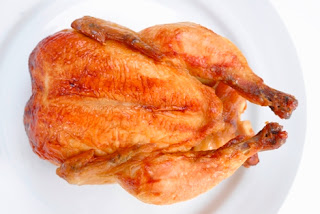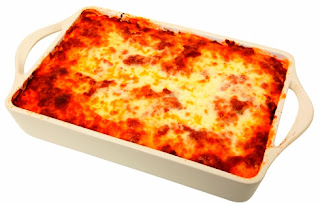My brother and I once ruined the family Thanksgiving with arguing about
whether sweet potatoes and yams were the same or different types of potatoes.
Turns out we were both wrong. They are members of different families, and
neither is actually a potato. Neither of them would have been eaten by the
Pilgrims at the first Thanksgiving, because neither had yet been introduced
into New England. In any case my mother smothered whichever one she used with
brown sugar, marshmallows and maple syrup, so that it mattered little what lay
under all that.
Candied Sweet Potatoes was a Good Housekeeping favorite recipe for
Thanksgiving. Since then I have come to love the real taste of sweet potatoes
(or yams) and prefer to cook and eat them in simpler style.
To write this article, I began an Internet investigation to determine
the differences between sweet potatoes and yams, but instead of clarifying the
issue, my research caused greater confusion. All authorities seem to agree that they are two
different plants with different botanical and geographic origins. The confusion
is traced back to when sweet potatoes became an important crop in the American
South. The African slaves referred to them as "nyami" (a crop they
were familiar with in Africa). They became "yams," which led to the US Department of Agriculture
requiring that yams also be identified as "sweet potatoes." No wonder
we are all confused.
Some culinary experts, however, say that sweet potatoes are moist and
sweet, while yams are dry and starchy. Others insist that yams are the sweeter
of the two. There are hundreds of
varieties of sweet potatoes, some of which, I am led to believe, are sweeter
and more moist than yams, but others, maybe not. The single most important
difference for cooks and consumers is that yams (rough, scaly brown skin and
fairly light-colored flesh) are low in beta-carotene, while sweet
potatoes—which usually have a smooth, darker skin and could have any shade of
flesh from pale yellow to deep orange or even purple—are high in beta-carotene.
The darker the “meat,” the more beta-carotene, and therefore the more
antioxidants and health benefits.
In all of the following tips,
suggestions and recipes, sweet potatoes and yams are interchangeable.
Selecting and
storing sweet potatoes
Choose sweet potatoes with unblemished skins. Never refrigerate raw sweet potatoes, as it tends to harden the flesh and develop an unpleasant flavor. Sweet potatoes are best stored at a cool room temperature (55° F–65° F). Cooked sweet potatoes, whether whole, mashed or candied, can be refrigerated for about a week or frozen for two- to three months.
Choose sweet potatoes with unblemished skins. Never refrigerate raw sweet potatoes, as it tends to harden the flesh and develop an unpleasant flavor. Sweet potatoes are best stored at a cool room temperature (55° F–65° F). Cooked sweet potatoes, whether whole, mashed or candied, can be refrigerated for about a week or frozen for two- to three months.
Cooking sweet
potatoes
Scrub the potatoes and boil or steam them with the skins on, which helps retain nutrients, for about 20 minutes for medium-size potatoes. Once cooked, the skins practically slide off, although they can be eaten as well.
Scrub the potatoes and boil or steam them with the skins on, which helps retain nutrients, for about 20 minutes for medium-size potatoes. Once cooked, the skins practically slide off, although they can be eaten as well.
Baked
Sweet Potatoes
Baking them whole is one of my favorite ways of eating sweet potatoes. Plain, without the addition of any other ingredients, they are not particularly fattening, weighing in at an average 141 calories per spud. Look for sweet potatoes of the same size so that they require the same length of time in the oven. Bake 35- to 45 minutes (depending on size), until potatoes feel soft to slight finger pressure or a fork can be inserted easily.
Baking them whole is one of my favorite ways of eating sweet potatoes. Plain, without the addition of any other ingredients, they are not particularly fattening, weighing in at an average 141 calories per spud. Look for sweet potatoes of the same size so that they require the same length of time in the oven. Bake 35- to 45 minutes (depending on size), until potatoes feel soft to slight finger pressure or a fork can be inserted easily.
Mashed Sweet Potatoes
Rinse but do not peel and then boil or steam medium-size potatoes about 20 minutes, until very tender. Remove the skins and mash or puree. For every pound of potatoes, add two tablespoons of unsalted butter, 1/8 teaspoon of ground nutmeg, salt and pepper to taste, and two to four tablespoons of milk or cream.
Rinse but do not peel and then boil or steam medium-size potatoes about 20 minutes, until very tender. Remove the skins and mash or puree. For every pound of potatoes, add two tablespoons of unsalted butter, 1/8 teaspoon of ground nutmeg, salt and pepper to taste, and two to four tablespoons of milk or cream.
Sweet Potato Fries
Preheat oven to 425° F. Rinse and pat dry the sweet potatoes. Peel, cut in half and then cut into ¾-inch slices so they look like fries. Spread them out on the baking sheet so they are evenly spaced and not touching (this is important, or they will become soggy, not crispy), season with sea salt and freshly ground pepper and drizzle with olive oil. Mix them so that each fry is slightly coated with the oil and salt and pepper. Bake for 15 minutes, and then turn each of them over and bake another 10–15 minutes, until they are fairly dark and crispy.
Preheat oven to 425° F. Rinse and pat dry the sweet potatoes. Peel, cut in half and then cut into ¾-inch slices so they look like fries. Spread them out on the baking sheet so they are evenly spaced and not touching (this is important, or they will become soggy, not crispy), season with sea salt and freshly ground pepper and drizzle with olive oil. Mix them so that each fry is slightly coated with the oil and salt and pepper. Bake for 15 minutes, and then turn each of them over and bake another 10–15 minutes, until they are fairly dark and crispy.
Sweet Potato
Casserole
Preheat oven to 350° F. For eight people, mix 4 cups of mashed sweet potatoes, 1 cup of brown sugar, 2 lightly beaten eggs, a half cup of milk, a half cup of melted butter and a teaspoon of vanilla, and place mixture into a greased 2-quart casserole dish. Make a topping by combining a half cup of brown sugar, one-third cup of flour, one third cup of melted butter and a cup of chopped pecans. Sprinkle the topping over the sweet potato mixture and bake for 35- to 40 minutes, until hot and browned.
Preheat oven to 350° F. For eight people, mix 4 cups of mashed sweet potatoes, 1 cup of brown sugar, 2 lightly beaten eggs, a half cup of milk, a half cup of melted butter and a teaspoon of vanilla, and place mixture into a greased 2-quart casserole dish. Make a topping by combining a half cup of brown sugar, one-third cup of flour, one third cup of melted butter and a cup of chopped pecans. Sprinkle the topping over the sweet potato mixture and bake for 35- to 40 minutes, until hot and browned.









